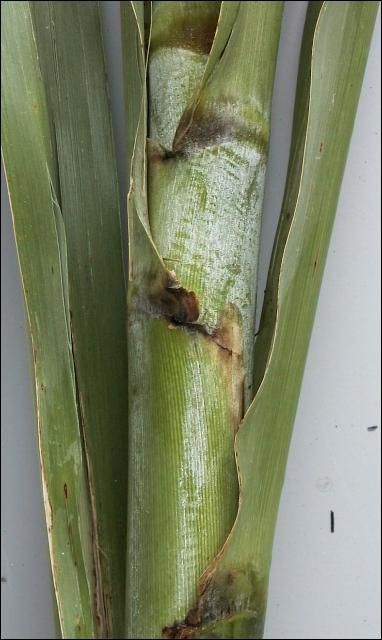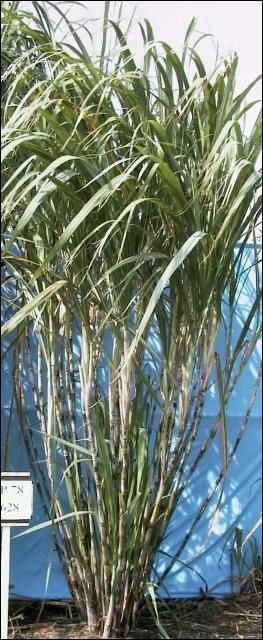The selection of a sugarcane cultivar that eventually becomes a production success is probably due in equal parts to the cultivar's attributes, word of mouth, gut feeling, and luck. This fact sheet provides many of the attributes cultivar identification is based upon. Some of these you will use as the basis for cultivar selection.
Since each farm has a unique set of environmental conditions and cultural constraints under which management must operate, a successful cultivar for one grower may perform poorly at another location. Therefore, watch new introductions as they are evaluated, monitor new plantings on your own farm or your neighbor's farm, and expand acreage of newer cultivars when you feel comfortable with their performance.
Sugarcane Cultivar CP 78-1628
Descriptive terms that apply to sugarcane cultivar CP 78-1628 are presented in Table 1. This cultivar used to be widely grown in both muck and sand soils in Florida, but its susceptibility to rust and smut diseases drastically dropped down it's acreage. CP 78-1628 is not a principal cultivar (cultivar with >1% of total sugarcane acreage) anymore in Florida (VanWeelden et al. 2022) but it is still grown in some Central American countries.

Credit: UF/IFAS

Credit: UF/IFAS

Credit: UF/IFAS

Credit: UF/IFAS
Glossary of Terms Used in Table 1
Cultivar Name: The first two letters in the cultivar name represent the source of the cultivar. CP stands for Canal Point where the cooperative sugarcane cultivar development program takes place. The participants are USDA-ARS, University of Florida Institute of Food and Agricultural Sciences (UF/IFAS), and the Florida Sugar Cane League, Inc. The next two numbers represent the year the first clonal crop of a given cross was planted. The numbers after the hyphen represent the accession number of that cultivar in the year it was named.
Soil Preference: Describes soils where the best performance of this cultivar can be expected. Under Florida conditions, this refers to either sand, organic (muck), both, or transitional soils. Transitional soils are organic soils that contain a large percentage of sand, or sand soils that contain a percentage of organic matter.
Sugar Content: This is an estimate based on comparisons with other commercial cultivars made at the UF/IFAS Everglades Research and Education Center. Because a range of values makes up a rating category, cultivars with the same rating are not necessarily equal. Ratings change as the harvest season progresses and are one of the determining factors of preferred harvest season. Rated as low, medium, or high.
Tonnage: Based on harvesting experiences over several years. This is a relative term and is influenced by soil type, location, harvest season, and ratoon being harvested. Rated as low, medium, or high.
Leaf Width: Measuring the widest part of the leaf at the fourth node from the top. Expressed as wide, medium, or narrow.
Sheath Pubescence: Using young sheaths at the top of the plant, rated as none, sparse, or dense.
Leaf Retention: Dead leaves may be tightly retained giving a trashy appearance, may be held on but easily shaken off, or may be self-stripping. Rated as attached, loosely attached, or self-stripping.
Canopy Characteristics: Canopy characteristics vary from compact to open, which influence sunlight penetration and sucker growth. Canopy growth habit can be classified as erect, erect with drooping tips, high arch, medium arch, or wide arch.
Canopy Closure: Speed of canopy closure influences weed and sucker growth. Rated as slow, intermediate, or fast.
Tillering: The number of shoots from a stool strongly influences potential yield. Number of tillers rated as low, medium, or heavy.
Stalk Size: Diameter relates to cane weight and susceptibility to lodging or bending. Rated as small, medium, or large.
Exposed Stalk Color: Rated as yellow, green, wine, red, purple, brown, or a described color.
Stubbling Ability: This is the ability of a cultivar to regrow after harvest. It may be strongly influenced by the height of the cutter blade above the soil line. Rated as poor, fair, or good.
Harvest Season: Harvest begins in late October and concludes in late March to early April. Some cultivars produce high sugar early which declines with bloom, some reach their peak later in the season, while others maintain a relatively high sugar content for an extended period. A narrow window of optimum harvest limits the flexibility needed for an orderly harvest operation and could be considered a disadvantage. If a cultivar's optimum harvest season is limited, but it fills an industry need for a cultivar during that time frame, it would be considered an advantage. However, it would be a disadvantage if a late maturing cultivar was also freeze susceptible. Rated as early (10/15–12/1), mid (12/1–1/25), or late (1/25–3/15).
Harvestability: Some cultivars grow very erect while others are prone to fall over (lodge). The erectness and degree of lodging influences the ability of mechanical harvesters to cleanly harvest a field in a timely manner. Often a cultivar will lodge uniformly in one direction and can be successfully "peeled" away from the adjoining row during harvest if it does not break. Rated as easy, moderate, or difficult. (Peel: To harvest a field from the direction from which the wind blew the cane down. If the cane is lying to the south, harvest the field from the north, working across the field to the south.)
Cold Tolerance: This has to do with the length of time a variety is able to maintain economic quality after a freeze. Rated as poor, medium, or good.
Frost Tolerance: This has to do with the ability of young cane to withstand or regrow after exposure to one or more frosts. Rated as poor, medium, or good.
Mechanically Cut Seed: Ease with which a cultivar can be harvested with a whole stalk harvester. The stalks are laid in furrows either by hand or machine and then cut into billets by hand. The other mechanical planting option is a billet planter, which chops the cane as it is harvested, creating more cuts and eye damage than the whole stalk harvester. Rating here is for the whole stalk method unless otherwise stated. Rated as poor, medium, or good.
Disease Concerns: After release, cultivars are considered to have adequate disease resistance to all of the important diseases recognized by the industry at that time. Therefore, disease concerns listed are the result of new strains of common diseases, or new diseases that have become important.
Advantages: A reason to plant this cultivar (e.g., high water table tolerance).
Disadvantages: A reason to plan carefully when considering this cultivar for planting (e.g., frost susceptibility).
Acknowledgements
The authors wish to thank Florida Crystals Corporation and Norman Harrison for assistance with cultivar photographs, and Serge Edme and Barry Glaz from the USDA/ARS Sugarcane Field Station and Barney Eiland and Raul Perdomo from Florida Crystals Corporation for their contributions and reviews.
Reference
VanWeelden, M. T., S. Swanson, W. Davidson, M. Baltazar, and R. Rice. 2022. "Sugarcane variety census: Florida 2021." Sugar Journal 85(2): 12-18.